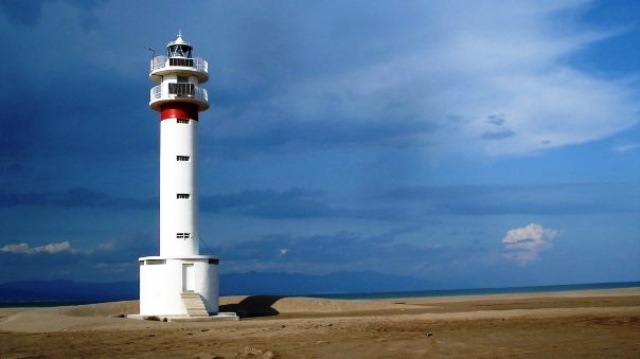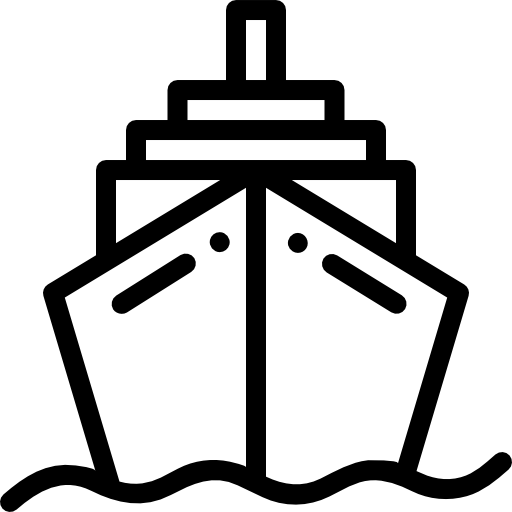FANGAR LIGHTHOUSE
HISTORY
Located at the Fango Points – a descriptive name for the type of soil of the Delta - this lighthouse was lit for the first time on 1st November 1864 with a catadioptric, sixth order device with three zones and 150mm focal length, purchased at the English Chance Brothers company. It elevated the focal plain to 9m above sea level and 8m above land. It cost 78,196 copper reales, an amount that included the building, the lamp and the lens. In the form of a six-sided pyramidal shaft and small living space, it was made entirely of English iron and the exterior was covered by plaster sheets and the interior by wood. There was a pillar at each corner and another central one, all sunk into the sand which assured its stability and elavated the living quarters above the ground to avoid flooding. Although the device was a simple one, the lighthouse was manned by two keepers due to its isolated location. A controlled olive oil lamp was used for lighting until, the use of petroleum became widespread throughout Spain and it was then substituted by a Maris wick lamp. Previously, this lamp had already been replaced by an AGA signal light that used acetylene as fuel. Acetylene was produced on site using a gas engine that used calcium carbonate as raw material.
This installation lasted until 15th April 1929, the date on which a new system of incandescent bulb was introduced, also acetylene run, with Dalen signal lights from the same Swedish AGA company. It relied upon an automatic bulb changer, a solar valve for ignition, a 15 litre gas burner and four AK-25 batteries to store the gas. Thanks to this it became a 2 + 1 screened white flashing light repeated every 15 seconds (light 4.5" Dark 1.5" light 4.5" Dark 1.5" light 4.5" Dark 1.5" = 15") and a reach in ordinary time of 10 nautical miles.
This last reform meant the automation of the signal and the redundancy of the personnel. The service was merged with that of the Buda island lighthouse and was attended by one solitary keeper who was housed at the residence in La Cava. He would carry out the checks and maintenance visits by way of a horse drawn carriage on a journey that took two and a half hours. He was paid 1.50 pesetas a day for his work plus 134.60 pesetas to cover housing and furnishings. A description form 1894 gives us a detailed account about him, from which can be deduced the living conditions in his dwelling: “6th order device, fixed white light in all directions, placed on the point of its same name. The focal plain to 7,50m above sea level and 6,80m above land. The range of its light 8 miles. Attended by two keepers paid 0.75 pesetas a day. The building is made of iron, mounted on six columns and because of this the rooms are very small and not enough for a couple with children. At the foot of the tower there is a hut that serves as storage space and has an area for each keeper that serves as a kitchen. If they should require any commodities, they have no alternative but to order the building of further housing for cooking and other domestic chores. The closest town is La Cava at a distance of 3 leagues from the lighthouse all on very bad roads. This town has a school for each sex, that because of distance cannot be attended by the keepers’ children. There are also two surgeons and a doctor who go twice a week from Tortosa.
There are two chemist’s and it lacks all trade because it is an agricultural town made up of huts and two or three houses. The lighthouse has a medicine chest and a delivery service that takes place twice a week by carriage (Mondays and Fridays) on each journey water from the Ebro is brought in barrels that are emptied into vats that exist for this purpose at the lighthouse. On Fridays the keepers hand over a list of food and any correspondance to the driver of the carriage and he, in turn, does the same with his colleague at Buda island, who is obliged to do the shopping for the Fangal keepers and perform any tasks they need doing from La Cava at Tortosa, the market where he purchases the provisions. He comes back on Mondays with the provisions on a launch by way of the Ebro to La Cava and here he hands them over to the carriage driver who takes them to the Fangal on the same day. The journey from Tarragona taking the Tarragona to Valencia train until Tortosa, costs: First class… 8.70 pesetas; Second class: 5.60 pesetas; Third class: 4.15 pesetas From Tortosa to La Cava there is a steamer that has a daily service; and if travelling on Sunday, the carriage service to the lighthouse can be taken advantage of; if it is not Sunday then the next service is on Thursday. The weather is good although not very healthy". The living quarters were small and the keepers had a minimal space split into a kitchen and a room for each one. They did not have a toilet or a cistern for drinking water. There was not any fuel storage space nor a workshop. In these conditions it was almost impossible for a family to reside in the lighthouse which forced the building of a hut that would serve as a comfort measure.
This housing was still insufficient and did allow for the obligatory inspection visits by the senior engineers. Because of this a new building was agreed which is described by the wife of the keeper Aguirre, who lived there in the twenties:
"There was an annex built out of masonry, small and built for the “Inspection” which was nice (I remember that in some of the rooms there were stucco decorations quite to my taste) in which (with the authorisation of the superiors) we installed our young family life, leaving all the accomodation of the lighthouse (which wasn’t much) to the Manager who lived with his elderly mother. To join the lighthouse to this annex there was a kind of path of 40m, on top of little bridges like gutters. In the middle distance, there was a hut where the “energy source” for the lighthouse was kept: a system of ordinary buckets, where the crumbled calcium carbonate stones were kept, to produce the necessary acetylene in a tank that was carried to the lighthouse by pipework".
To the isolation and inhospitability of the area had to be added one more inconvenience: The periodic floods that left the area under water. From the previous testimony we have a good example of what happened one calm dusk:
"…there was an alarming noise at the door of our dwelling, the banging and the loud voice of Manager, our friend Vallés, urging us with the utmost haste to immediately come outside and without giving any reasons, for us to go to the lighthouse. My husband believed it could be a dangerous fault in the lighthouse installation and we went, frightened, towards it instantly realising what was happening:
An unexpected high tide without warning from wind or weather, was flooding eveything covering sands, beaches and more and more. From the railing of the inverted cones, we could see perplexed, not understanding, how in a small of time, the sea a shapeless and relentless mass of water, was covering everything around us, the devastating current running underneath the lighthouse leaving us floating like a ship…"
To continue:
"... d'haver-nos quedat en l'interior, o retardat el nostre estimat company uns segons més, hauríem quedat atrapats dins, com en un submarí enfonsat i foradat...". .
These difficult conditions made the lighthouse a preferred candidate for automation and the removal of personnel which happened, as already mentioned, in April 1929. The same as happened at the Buda lighthouse the Fangal lighthouse was set on fire during the war and partially destroyed. This, together with the lack of personnel, brought about a rapid deterioration of the corroded building whose walls were dismantled. Only the tower was left which in 1956 was repaired reinforced and the framework toughened. Eighteen years later it could take no more. To substitute it, in 1972 a new beacon began service. It was an 8 metre high iron tower made up of two quadrangular prismatic bodies mounted on a concrete platorm 1.2m high. With an AGA LBSA-200 lamp, 200mm diameter polished glass lens, acetylene signal light and solar valve, it housed in its interior the AK-25 gas batteries and an access staircase to the upper level, that had two balconies surounding it. For a better daytime visibility it was painted in black and white stripes. New demands for a longer range decided the implementation of a new build. The fulfillment of this meant the construction of a tower, made of reinforced concrete, 20m high and 3m in diameter of the kind known as "standard type". The design of these towers was realised in April 1970 by the Commission for the Study of Models and Methods for Martime Signals, with the aim of facilitating the projects for new lighthouses that were at a standstill due to the low priority placed on these works by the engineers. This gave rise to continuous delays in the modernisation and improvement of the Spanish maritme signalling system.
Under the title “The Project for Official Models of Lighthouse Towers” three models were proposed of cylindrical towers with diameters of 3, 4 and 5 m respectively, allowing for the necessary height of the focal plane over the land.
Old images
https://www.porttarragona.cat/en/notes-de-premsa-rss/item/1756-fangar-lighthouse#sigProId16dc4b8f3a
Image Gallery
https://www.porttarragona.cat/en/notes-de-premsa-rss/item/1756-fangar-lighthouse#sigProId79d1c0d3c4























